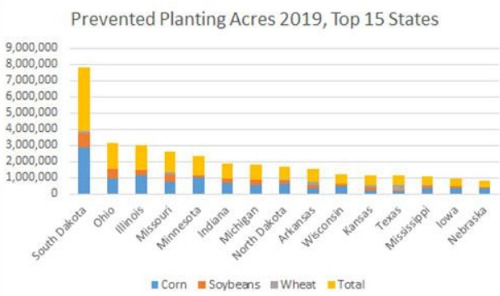By Amy Mayer
The U.S. Department of Agriculture has paid out a record $4.24 billion in claims for acres farmers couldn’t plant this year.
The “prevented planting” provision allows farmers to file a crop insurance claim when weather conditions leave fields unfit for a crop. Heavy spring rains and flooding left some Midwest farm ground too wet for seeds and equipment during the planting window, meaning farmers couldn’t put in the corn or soybeans they’d intended for those acres.
“It was a stand-out year since we’ve been keeping these records,” said USDA Risk Management Agency (RMA) administrator Martin Barbre. “It’s been the highest acreage we’ve ever had in prevented planting.”
All told, farmers submitted prevented planting claims for 11 million acres of corn and 4 million acres of soybeans.
The top three states for acres claimed were South Dakota, Ohio and Illinois.

University of Illinois agriculture economist Gary Schnitkey says prevented acres were disproportionately taken as corn.
Schnitkey and colleagues at Ohio State University considered claims in the context of how many acres of each crop historically get planted, what could have been expected this year and which crops were designated on prevented planting claims.
“The farmer has an incentive to call it corn because they’re going to get a higher payment on it than on soybeans,” Schnitkey said. That’s because the formula used to calculate payments considers, among other factors, that the cost of planting corn is typically higher than planting soybeans.
“There is a rule in RMA rules that says farmers had to intend to plant it,” Schnitkey said, “but there’s no real way to enforce that rule because you’ve reported your intentions to no one.”
It’s not that farmers can claim all their prevented acres as corn. Only historical corn acres are eligible for a corn claim. An example helps clarify how it works:
If a farmer has 1,000 acres and divides it evenly every year, then if he planted 500 acres of corn this year, he would only be able to claim soybeans as prevented planting. But if he has planted 700 acres of corn in one of the past four years and this year he planted 500 in corn but had 200 acres he couldn’t plant due to flooding, he could call those corn acres even if he was really planning to plant soybeans there.
Schnitkey said the system could nudge farmers toward always planting more corn than soybeans.
“In my opinion, there probably should be reforms to prevent plant,” Schnitkey said. He added that the program is tied to an overall crop insurance premium, which he says may not make the most sense. “Prevent plant is meant to cover the cost that had been incurred. Well, your prevent plant coverage is going up as you increase your coverage level, right? So people that buy higher coverage levels are getting more prevent plant coverage.”
RMA’s Barbre said he isn’t concerned that hypothetical prevented planting claims influence planting intentions.
“There’s so many more factors that go into that,” he said, including that for most places corn is a higher revenue crop.
In some cases, Barbre said, a farmer may be able to take prevented planting on corn and still get a soybean crop in the field. Then the prevented planting claim is reduced to 35 percent of the corn indemnity.
“It takes into account the expenses you may have had for corn, different types of fertilizer you may have already applied, seed you’ve bought, different labor things you may have in place,” Barbre said, “And at the same time, somewhat in a roundabout way, it accounts for the fact that you’re planting a soybean crop a little bit later, too.”
The crop insurance industry and farmer premiums are supported with taxpayer subsidies through the Federal Crop Insurance Act and the Farm Bill.
Source : illinois.edu